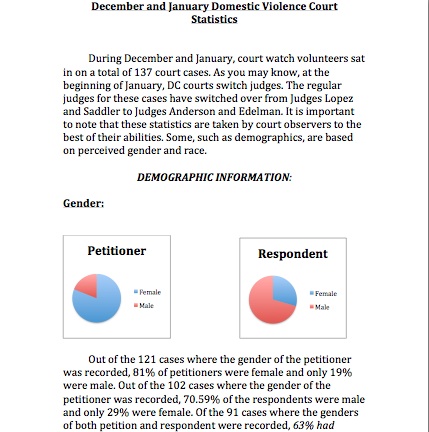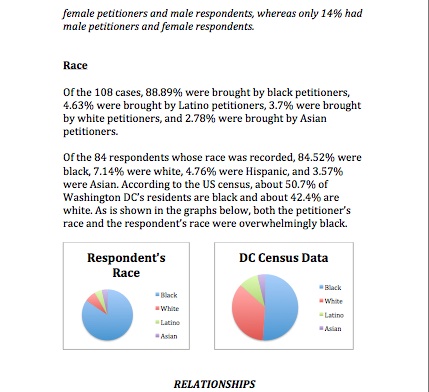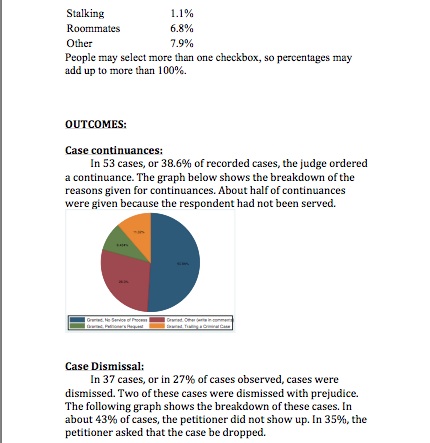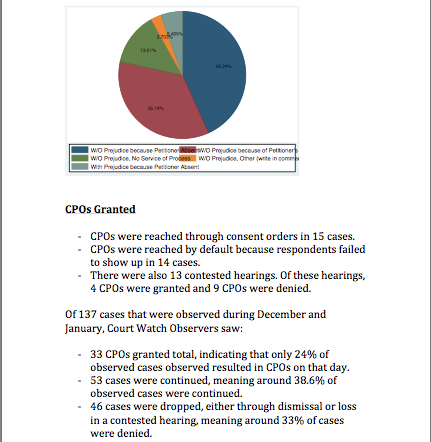In this Court Watch Project post, we will be discussing the general outcomes of cases heard by CWP volunteers from January – May 2012. When a petition for a Civil Protection Order (CPO) comes before the court, there are six different things that can happen: a Dismissal Without Prejudice, a Dismissal With Prejudice, a Continuance, a Default Judgment, a Consent Order, and a Contested Hearing. An explanation of each of these situations follows, but can also be found here and here.
When a case is Dismissed Without Prejudice, the judge dismisses the case from the court without entering a CPO. No testimony is taken, no facts are entered into the official court record, and no parties are legally obligated to do anything further. Cases are normally dismissed without prejudice for one of three reasons: the Petitioner is absent and does not appear before the court to bring his or her case, the Petitioner voluntarily agrees to drop the case and move on without a CPO, or the Petitioner is having repeated trouble serving the Respondent with a copy of the petition. If a case is dismissed without prejudice, Petitioners always have the option to file another petition based on the same events.
On the other hand, when a case is Dismissed With Prejudice, the Petitioner does not have the ability to bring the case again. The judge still dismisses the case from the court, and no CPO is entered, but the option to file another petition is not granted. The issues addressed in the original petition will not be heard before the court ever again. This is a relatively rare occurrence, and can be done to penalize Petitioners who are seen as persistently misbehaving (interrupting court proceedings, “acting out” in court, etc). The judge may also decide to dismiss a case with prejudice if the Petitioner has had many chances to try to get the respondent served (see “Continued”), but is unsuccessful. The judge may perceive that the Petitioner is does not actually want the CPO or that the Petitioner is no longer in danger because they cannot locate the Respondent. Though this occurs rarely, it can still be problematic for Petitioners when the Respondent is effectively and consistently evading service.
Sometimes the court or the parties are unable to proceed with a case on the day that it has been scheduled for. If this happens, the case may be Continued (rescheduled for another day, typically two weeks in the future). Cases may be continued for many reasons; though they can pose problems for both the Petitioner and the Court, they are often necessary. If a Petitioner wants more time to successfully serve the Respondent or seek legal representation, he or she may ask the court for a continuance. As you will see in the data, continuances are routinely granted. Check out a previous post on the causes and repercussions of continuances with data gathered in February 2012.
If the Petitioner successfully serves the Respondent with the petition and an order to appear on the court date, the Respondent must appear. If the Respondent fails to appear despite having received service, the Petitioner will likely receive a Default Judgment or Default Order. In this situation, a CPO is entered and goes into effect based on the testimony of only the Petitioner. Since the Respondent had the opportunity to defend against the allegations in the petition and the terms of the order, but chose not to, a CPO will be entered against him or her despite the absence. Following a default judgment, a bench warrant will be issued for the Respondent’s arrest so that he or she can be brought before the court to explain the absence and be given a copy of the new CPO.
If both parties are present they may enter into a Consent Order before their case is ever called. In this situation, the Petitioner and the Respondent both agree to have a CPO in effect, but the Respondent does not formally admit to any wrongdoing. If Petitioner files another case against Respondent or chooses to pursue other options, the fact that the Respondent agreed to a consent order cannot be used as evidence of any misconduct on his or her part. After the judge signs the consent agreement, the agreed-upon CPO will be in effect for one year.
If a consent order is not possible and the parties have no other recourse, they can proceed with a Contested Hearing. A contested hearing represents a full adjudication of the issues between the parties, with the judge acting as the finder of fact. Both parties will give testimony, the judge will decide who he or she finds more credible, and the judge will decide whether or not, based on the credibility of each side’s evidence, to grant a CPO. Only a small percentage of cases end with contested hearings.
Based on the statistics that have been gathered by SAFE volunteers between January and May of this year, here is how the final decisions of cases have been distributed:
- 255 cases were Dismissed Without Prejudice (173 because Petitioner was absent, 73 by Petitioner’s request, and 8 because of repeated difficulties in serving the Respondent with the petition)
- 6 cases were Dismissed With Prejudice
- 66 cases ended with a Default Judgment
- 157 cases ended with a Consent Order
- 25 cases ended with Contested Hearings (20 Petitioners were granted CPOs, 5 were not granted CPOs)
In cases where Court Watch Volunteers were recording data, 47.8% of petitions filed so far this year ended with the entering of a CPO by the court. Most of these CPOs were obtained through Consent Agreements.
The most common outcome for cases is to be dismissed without prejudice. Over half of all cases filed so far this year recorded by Court Watch Project Volunteers, were dismissed. The absence of the Petitioner accounted for the dismissal of 34% of all cases. While it is important for Petitioners to make their court dates, there are many legitimate reasons for an absence. For example, Petitioners may be too afraid of seeing the Respondent to appear before the court, Petitioners may have difficulties finding someone else to care for their children, or Petitioners may have difficulties getting to the courthouse, just to name a few. There are many legitimate reasons for Petitioners to be absent, and if a Petitioner still feels strongly afterwards about getting a CPO, he or she is free to come to the courthouse and re-file a petition at any point. Additionally, Petitioners have the option of meeting with a SAFE Court Advocate who can help the Petitioner safety plan around potential barriers that make it difficult, dangerous or impossible to come to court on the day of the CPO hearing.















